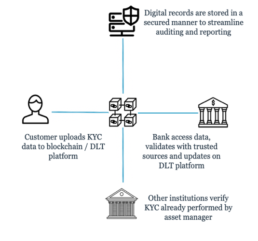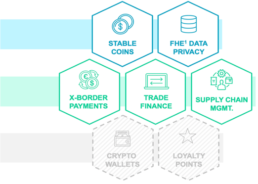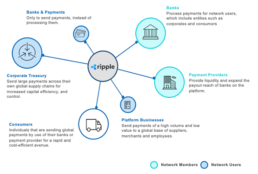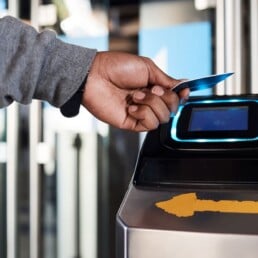How did we get here?
ORIGINS TO PRESENT DAY
It is no surprise that the financial services industry has been a fertile valley for technological disruption. The rise of online banking powered by bank mainframe computers was an early testament to this. It fundamentally altered the relationship between end-consumers and financial institutions by rendering branch visits no longer necessary. Eventually we reached a point at the turn of the 21st century where the bulk of internal processes and external interactions of banks had become fully digitized. Today we witness:
- Electronic trading platforms that facilitate trades on capital markets in real time
- Mobile payment offerings which exchange funds have become commonplace as smartphone penetration reaches record levels around the world
- Robo-advising platforms that provide algorithmic-based portfolio recommendations, lowering costs and enhancing alpha through the automated analysis of enormous volumes of data
- Cloud-enabled CRMs that allow banks to monitor their relationships with clients, creating a stronger feedback loop which helps improve offerings
In short, great strides have been made to augment both top and bottom lines.
BUBBLING TENSIONS & BLOCKCHAINS
Interestingly, this has all occurred amidst the backdrop of increasing societal distrust of the financial system, particularly in the aftermath of the 2008 Global Financial Crisis. While consumers have definitely benefitted from these innovations, institutional players themselves have been the biggest winners from these developments.
For decades, this consortium of legacy players has served as the foundational layer of trust and been robust to external shocks. At the same time, the necessary existence of these intermediaries has allowed for significant rent extraction (for instance, on only 55-65% of insurance premiums typically go towards paying claims, while 45-35% is accrued to administrative costs and corporate profits)
While substantial profit margins are not inherently something to condemn, does intermediation in of itself still create value in line with broader economic growth and fair market evolution, especially now that technology is starting to remove its necessity?
In response to this sentiment, we are now witnessing a new paradigm within finance, one that synthesizes financial products with decentralized networks. Decentralization refers to ecosystems where administrative power is not concentrated in a single intermediary, but rather distributed across actors that are economically incented and cryptographically bound to cooperate harmoniously. Such a system of organization has gained immense popularity since the launch of Bitcoin in 2009 and the subsequent obsession with exploring the applicability of blockchain ledgering and other types of distributed ledger technologies (DLTs). In this model, software code seeks to become the new layer of foundational trust. This is manifested by immutable smart contracts verified and timestamped on a blockchain (a kind of distributed database that requires redundancies and the absence of a single central coordinator), such as Ethereum or EOS, that virtually anyone can create (with a little know-how) and no malicious actor can unilaterally appropriate (ideally). The promise of this disintermediation is vast indeed, as it implies two crucial elements:
1. The democratization of access as, anyone with an internet connection can access financial services regardless of the wealth, relationship, location, and other requirements typically imposed by intermediaries.
2. The security of trustless operations as blockchain-enabled transactions provide security and retain custodianship of user assets, without validation from a central party — a crucial feature for those living in areas of poor governance or under the duress of a surveillance state.
Why does it matter now?
INCLUSION & OPPORTUNITY
The extent of this rapidly materializing opportunity is apparent by the sheer multitude of people who currently exist either outside of or on the extreme periphery of the current global financial system:
- ~ 1.7 billion adults around the world (roughly a third, globally) have trivial to no access to formal financial services.
- The vast majority of the unbanked can be found in emerging markets
- This majorly comprises women and individuals from households ranking in the bottom 40% by income of their respective countries
- Often, these individuals tend to lack personal documentation and IDs that would allow them to engage with the current financial system (e.g. rural dwellers and migrant workers) which further perpetuates their condition of poverty
- Interestingly, this phenomenon is present even in high-income countries, like Singapore, for example, which sports an ID-less rate of an alarming 37%
Therefore, it is not a surprise that bringing the entire unbanked population into the fold of the existing formal financial system can generate an estimated whopping $380 billion in new revenues.
That being said, it is critical to note that the unbanked populace still leads an active financial life through informal financial services, such as the local pawn broker or village money lenders. Thus, the savviness and cognizance of financial wellness exists, at least latently. Furthermore, the expansion of brick and mortar infrastructure carries little economic feasibility in many of these geographies.
Consequently, pre-existing smartphone and internet connectivity now offers a unique avenue of entry for decentralized networks to reach the unbanked. Again, they are unbanked but not unaware. The informal economy is a testament to their understanding of the importance of financial wellness, as well as the roles and responsibilities of various parties in a transaction. Given that blockchain-ledgering can allow for the creation of digital identities, decentralized financial applications can begin catering to the needs of these 1+ billion people from the outset. They can keep costs low through the exclusion of expensive intermediaries and provide transaction security regardless of someone’s level of personal documentation.
Figure 1: Illustration of identity creation and management on a DLT-powered platform that banks can tap into
Our prediction is that decentralized networks will capture much of the wealth generated as millions more are lifted out of poverty and subsistence living, as a result of macroeconomic factors and projected global economic growth in the decade to come. In fact, the global middle class is expected to increase 2.7 times from approximately 2 billion in 2009 to 5 billion in 2030, indicating a jump from $21 trillion to $56 trillion in global middle-class expenditure. As decentralized finance will be the beachhead infrastructure for those on the cusp of entering the middle class and the banked world, it will also be one of the primary arenas where this wealth accretion will occur. Players looking to move into the space now will be in a unique position then to capitalize on it. This will include new revenues through the provision of investment opportunities, lending options, insurance policies, and a whole host of financial products that become more relevant as disposable incomes increase.
Ultimately, by recognizing:
1. the unique trustless value proposition and digital reach decentralized finance has to offer, and
2. the sheer quantity of people who exist outside of formal finance but are financially aware, and
3. the projected explosion in the world-wide middle class
we can now appreciate the enormous and long-lasting social and economic dividends available through this radical inclusion enabled by decentralized finance.
What lies ahead?
A BRAVE NEW WORLD
Beyond pushing the boundaries of inclusion, the scope of what is considered a viable financial product is also rapidly broadening. Tokenization, the act of representing real world assets with tradable tokens generated on blockchain ledgers, will allow individuals to gain exposure to assets they were previously barred from, such as private equity or real estate, effectively increasing the liquidity and flexibility for owners.
Micropayments between parties that regularly transact with each other (like consumers tipping content creators) will become economically feasible by being conducted off-chain – without transaction-level validation on the blockchain – for speed and scalability while the beginning and end states of these interactions will be settled on-chain at regular intervals to ensure security (as we are witnessing with Bitcoin’s Lightning Network). Algorithmic stable coins, which leverage supply balancing techniques to maintain constant pricing equilibria, will serve as a dependable store of value for lending, salary payouts, remittance, trading strategies, and a host of other functions. Communal insurance policies can be formulated where surpluses are re-invested into the community, as dictated by smart contracts that are automatically executed when pre-determined conditions are met. Consequently, we can now picture scenarios such as:
- Shopkeepers of an ethnic neighborhood in Manhattan on the coast can create a communal flood insurance policy to safeguard century old businesses and retain the cultural heritage of their geography
- A Venezuelan family can store their wealth in digital money with programmed (as opposed to human-orchestrated) scarcity, like Bitcoin, to minimize exposure to the hyperinflation of the government-backed Bolívar
- Readers of a Sudanese political satirist can support her work through stable coin payments per view of publication
- An immigrant in the United States can send remittances back to family members in her country of origin without costly money transfer fees
- A middle-class individual in Pakistan can borrow from a Canadian lender to invest in a real estate development in Brazil in a frictionless manner
Figure 2: Selected list of popular types of DLT applications within financial services
The common motif that runs through these scenarios is that of self-empowerment. The next incarnation of finance will empower individuals by meeting their specific needs and narrow interests in a way that previously could not have been facilitated by intermediated finance due to a lack of economic incentive. Disintermediation, afforded by DLT-powered trustless environments, creates the demand for all sorts of niche services that decentralized networks and protocols can cater to and unlock previously untapped value from.
At the same time, corporations like banks stand to significantly benefit as well from decentralization-enabled advances in process streamlining. For example, Ripple, the blockchain-based payment protocol, is upending (among other things) traditional interbank transactions and rendering older infrastructure, like SWIFT, obsolete by allowing for virtual real-time settlement (two seconds in actuality) of global payments: a $2 trillion market that is poised for disruption through this radical efficiency. And while these revolutionary opportunities looming on the horizon are undoubtedly exciting and will transform conventional finance as we know it, the path ahead is not without its own unique set of intricate complexities and multi-faceted hurdles.
Figure 3: Mapping of Ripple’s value proposition and multi-faceted infrastructure revolutionizing payments
IMPENDING CHALLENGES
The underlying infrastructure of decentralized networks is still being built. Technical problems of scalability (featuring lively debates on which consensus algorithms are optimal, what constitutes the ideal mix between Proof-of-Stake and Proof-of-Work, the role of Layer 2 protocols, etc.) are just as present as (and to a great extent, intertwined with) issues of compliance with existing regulatory frameworks.
Different types of blockchains have differing takes on issues such as — how consensus verifying the integrity of data is to be achieved, how decentralized the decision-making process ought to be to achieve consensus, the respective decision-making abilities that should be delegated to different kinds of stakeholders, what sort of value can be tokenized, etc. The rules of consensus-making are both a function and a determinant of how scalability and reasonable throughput can be achieved across a blockchain.
This complexity is further compounded by differing regulatory requirements across jurisdictions and incongruent definitions of concepts, such as what constitutes a security, an investment contract, and AML/KYC compliance. This is why, as part of the infrastructural development and creation of enterprise standards, great attention is currently being given towards the interoperability of blockchains, bridging both technical and regulatory differences through modularity coupled with seamless integration.
A REAL (ESTATE) USE CASE
To further appreciate these challenges, let us examine an actual use case within decentralized finance. The tokenization of real estate is an apt utilization of DLT as it leverages the immutability of blockchain-ledgering and the programmable business logic of smart contracts. Such tokenization can enable secure fractional ownership of real estate assets, to improve market liquidity and generate efficiencies through transaction automation and speedier settlements.
For this to work in practice, the underlying blockchain platform must have the legal rights needed to store ownership information, transfer possession rights, and generate tokens representing the underlying ownership that can be redeemed for the appropriate value within a market. The tokenization and subsequent fractional selling of a property could be conducted in a manner deemed as a legal security offering in the EU, but illegal in China or the US. It is possible that the blockchain platform used can be compliant in one jurisdiction, but the property could be domiciled in a geography with a different regulatory regime altogether.
Furthermore, various tokens can be representative of different kinds of rights of the same underlying asset: tokens that allow for voting in governance decisions, equity tokens representing overall ownership, or specific claims tokens for mineral or water rights on a given property. This makes the formulation of business logic within smart contracts and the ability to conduct token-holder tracking, even across secondary markets, very critical.
Traditionally, the securitization of real estate has been chiefly done through Special Purpose Vehicles (SPVs) which levy fiduciary obligations and duties on the original asset owner. While tokenization has the potential to streamline this process, it is very likely that the creation of SPVs, which can be quite an involved process, will continue to be a reality for now. In fact, this underlying tension between new tactics and old understandings can be found throughout decentralized finance. The juxtaposition between novel methods of value creation with current compliance grounded within the intermediated finance paradigm requires a savvy approach to achieve economically beneficial harmonization.
The verdict
It is difficult to characterize this emerging phenomenon as anything other than exciting and brimming with opportunity. We are on the cusp of a revolution within financial services that will have far-reaching ramifications for the +1 billion unbanked, current models of financial intermediation across entities and borders, and ultimately the very nature of how end-consumers understand financial health. As this understanding held by customers evolves, so too must the operations, services, and visions of providers change if they are to remain relevant in an era where trillions of dollars of value generation are up for the taking.
Starting Your Journey
Which decentralized finance use cases do you believe will provide the highest ROI for your organization? Tokenizing your illiquid asset holdings? ERC-20 tokens could be good fit but ERC-223 is making a name for itself as well. Launching your own cryptocurrency to improve the speed of cross-border transactions? Creating a crypto-compatible trading platform? Timestapping the movement of products across the supply chain on a blockchain ledger to provide you a more transparent view of your vendors and distributors? Which platform should you build off and partner with? IBM’s Hyperledger Fabric? R3’s Corda? Maybe creating a sidechain on Ethereum makes more sense? Perhaps you want to build your own blockchain, which opens a slew of questions related to crypto economics, consensus algorithms, byzantine fault tolerance methods, and degrees of permissioned-ness…
There is no one way or standard method of providing financial products through decentralized networks. At the same time, different use cases may be more profitable or desirable than others depending on the circumstances of your organization as well as your strategic vision. It is important for businesses to understand what they ought to prioritize through a rigorous cost-benefit analysis and opportunity sizing as well as determining what capabilities are required and how to attain them (build vs buy vs partner). The processes of transforming opportunities into pilots and then converting those into sustainable, commercialized intitiatives or conducting due diligence on existing providers and integrating their offerings into your own are not easy tasks. Benefit calculations must incorporate risks by developing a range of projected outcomes that are sensitive to potential deviations.
Amidst this realm of questions and uncertainty emerging from the paradigm of decentralization, a crucial fact sticks out: plowing ahead in this new domain will be critical in maintaining a competitive edge and unlocking novel avenues for value creation. Kepler Cannon looks forward to working with our clients and partners to jointly navigate the new way forward as finance continues to evolve and we find ourselves at this new frontier: one that is dramatically different but all too enticing not to dive in head-first.






























